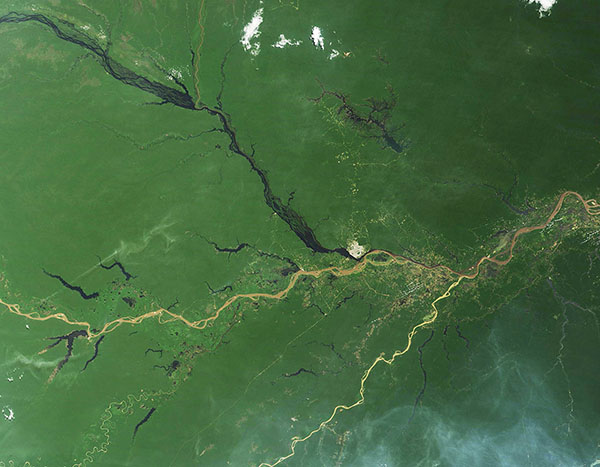Images
August 24, 2024 - Rivers of South America
Tweet
Multi-colored rivers cut through the heart of the Amazon rainforest, creating a wide range of habitats, including marshes, swamps, streams, and floodplains, each creating critical niches for a wide range of species. These rivers also go through a seasonal cycle, filling and sometimes flooding in the wet season and drawing down in the dry season. The driest month in the Amazon River Basin is August when the average rainfall is approximately 2 inches (5 cm). Rainfall is greatest in the wet season (December to May) and can exceed 8 inches (20 cm) per month.
The Moderate Resolution Imaging Spectroradiometer (MODIS) on NASA’s Terra satellite acquired a true-color image of several of South America’s most important rivers on August 21, 2024.
The wide, braided river filled with dark-colored water that drops towards the south is the Rio Negro. The water, tinted the shade of black tea, flows from the Colombian hills and interior jungles, and is colored by decayed leaf and plant matter. The Rio Negro flows into the mud-colored Solimões River (also known as the upper Amazon River) just east of the city of Manaus, where they form the Amazon River. The waters don’t immediately mingle, so a close look south and east of Manus (gray circle) shows a line of black water and a line of brown water flowing in the same riverbed.
The southernmost river in the image, also filled with muddy sediment, is the Maderia. This river is formed by the junction of two other rivers in Bolivia and flows northward to form the border between Brazil and Bolivia before turning northwest to meander towards Manaus. The Maderia joins the Amazon River about 90 miles (145 km) east of that city.
Image Facts
Satellite:
Terra
Date Acquired: 8/21/2024
Resolutions:
1km (122.2 KB), 500m (287.9 KB), 250m (687.8 KB)
Bands Used: 1,4,3
Image Credit:
MODIS Land Rapid Response Team, NASA GSFC
Tweet
Multi-colored rivers cut through the heart of the Amazon rainforest, creating a wide range of habitats, including marshes, swamps, streams, and floodplains, each creating critical niches for a wide range of species. These rivers also go through a seasonal cycle, filling and sometimes flooding in the wet season and drawing down in the dry season. The driest month in the Amazon River Basin is August when the average rainfall is approximately 2 inches (5 cm). Rainfall is greatest in the wet season (December to May) and can exceed 8 inches (20 cm) per month.
The Moderate Resolution Imaging Spectroradiometer (MODIS) on NASA’s Terra satellite acquired a true-color image of several of South America’s most important rivers on August 21, 2024.
The wide, braided river filled with dark-colored water that drops towards the south is the Rio Negro. The water, tinted the shade of black tea, flows from the Colombian hills and interior jungles, and is colored by decayed leaf and plant matter. The Rio Negro flows into the mud-colored Solimões River (also known as the upper Amazon River) just east of the city of Manaus, where they form the Amazon River. The waters don’t immediately mingle, so a close look south and east of Manus (gray circle) shows a line of black water and a line of brown water flowing in the same riverbed.
The southernmost river in the image, also filled with muddy sediment, is the Maderia. This river is formed by the junction of two other rivers in Bolivia and flows northward to form the border between Brazil and Bolivia before turning northwest to meander towards Manaus. The Maderia joins the Amazon River about 90 miles (145 km) east of that city.
Image Facts
Satellite:
Terra
Date Acquired: 8/21/2024
Resolutions:
1km (122.2 KB), 500m (287.9 KB), 250m (687.8 KB)
Bands Used: 1,4,3
Image Credit:
MODIS Land Rapid Response Team, NASA GSFC




